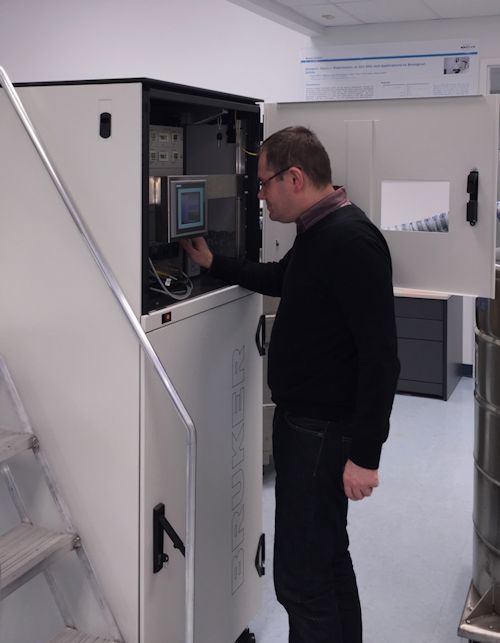Liverpool Chemist receives IOP – RSC Magnetic Resonance Prize

Dr Frédéric Blanc, Senior Lecturer in the Department of Chemistry, has been awarded the 2017 Institute of Physics – Royal Society of Chemistry Annual Prize for excellent contribution to magnetic resonance.
The prize is to recognised excellence of an early career researcher in the field of magnetic resonance and is awarded jointly by the Institute of Physics Magnetic Resonance society (BRSG) and the NMR Discussion Group (NMR DG) of the RSC every year. The prize will be handed over at the BRSG or the NMR DG Christmas in December where Frédéric will be be giving an invited lecture on his most recent work.
After a PhD in France, postdoctoral work at the State University of New York and an EU Marie Curie Fellowship at the University of Cambridge, Frédéric joined the Department of Chemistry in December 2012 as a Lecturer and was promoted Senior Lecturer in October 2016. His research is centred around the development and application of Nuclear Magnetic Resonance (NMR) spectroscopy across materials chemistry and in particular energy materials and supramolecular assemblies.
Frédéric says: “I am delighted to receive the 2017 BRSG - NMRDG Annual Prize. This is a recognition of the collaborative research efforts of my group, including those of the undergraduate students, to demonstrate all the fantastic contribution that solid state NMR has to enable atomic scale structure determination.”
In particular, Frédéric has made significant contributions to the field of Dynamic Nuclear Polarisation enhanced solid-state NMR. This is an hyperpolarisation NMR technique that dramatically speeds up the acquisition of NMR data by transferring the high polarisation of electrons (the polarising agent, added to the sample on purpose) to the low polarisation of nuclei and then detecting it.
Frédéric adds: “DNP is amazing; you only have to wait seconds to detect the NMR signals of solids, while previously it could have taken a day or longer to observe weak NMR signals. The development of transformative analytical techniques, or the adaptation of existing techniques, to determine chemical structure are directly enabling scientists to discover new materials which is vital to society, for example within the agenda of a sustainable development. I am looking forward to sharing my work at the next Christmas NMR meeting.”
He exploited this approach to obtain extremely rapidly in minutes signal-to-noise ratio NMR spectra of very insensitive nuclei (such as oxygen-17 at natural abundance, including at a very high magnetic field, or low-gamma yttrium-89), giving new insights into the structure of selected functional materials. Additionally, he showed that DNP allows efficient, time-effective and high-throughput characterization of supramolecular assemblies, enabling unprecedented details in the molecular structure of these complex polymer networks to be determined.
His research projects, funded by the Engineering and Physical Sciences Research Council, the Science and Technology Facilities Council and the Royal Society, also involve access to large scale NMR facilities, either in the UK (UK 850 MHz Solid-State NMR Facility at the University of Warwick; Nottingham DNP MAS NMR Facility at the Sir Peter Mansfield Magnetic Resonance Centre) or elsewhere (Very High Fields NMR Centre at the Université de Lyon; CEA in Grenoble; CNRS in Orléans; Magnet Lab in Florida), as well as collaboration with the industrial sector (NMR manufacturer Bruker).
Frédéric ends: “I am so grateful to all my colleagues over the years for providing access to these unique and fantastic NMR infrastructures which permits the science behind the Prize to be delivered”.
To find out more click here

Image: Frédéric by the temperature controller of the DNP NMR spectrometer at Bruker